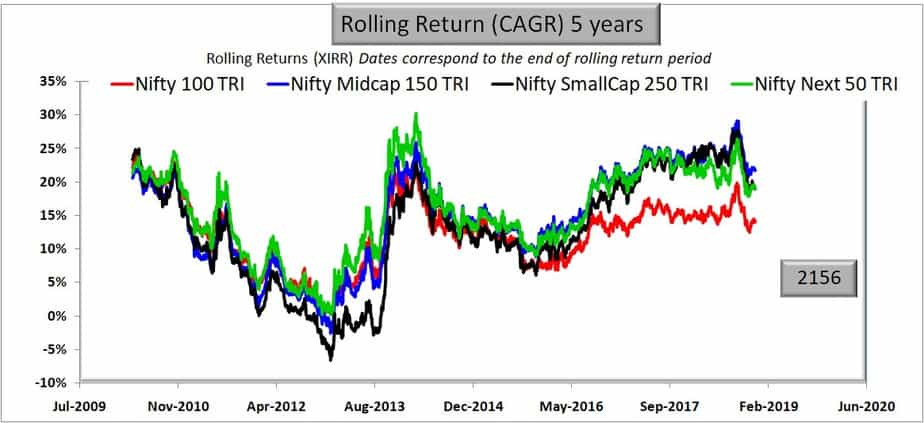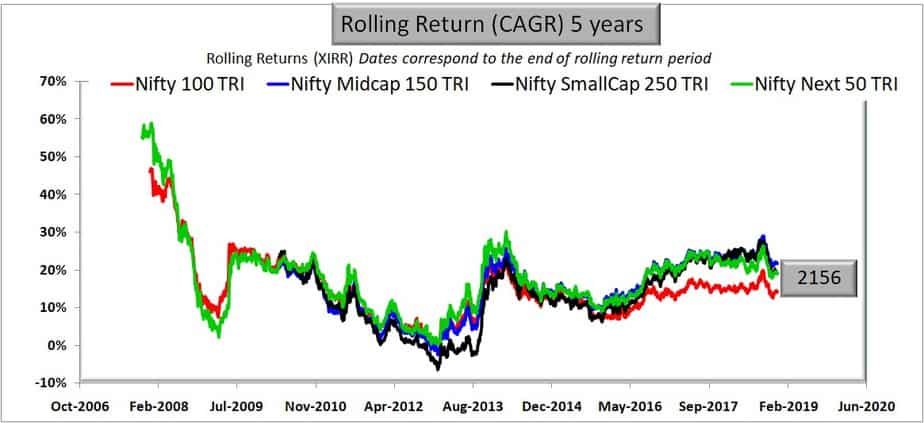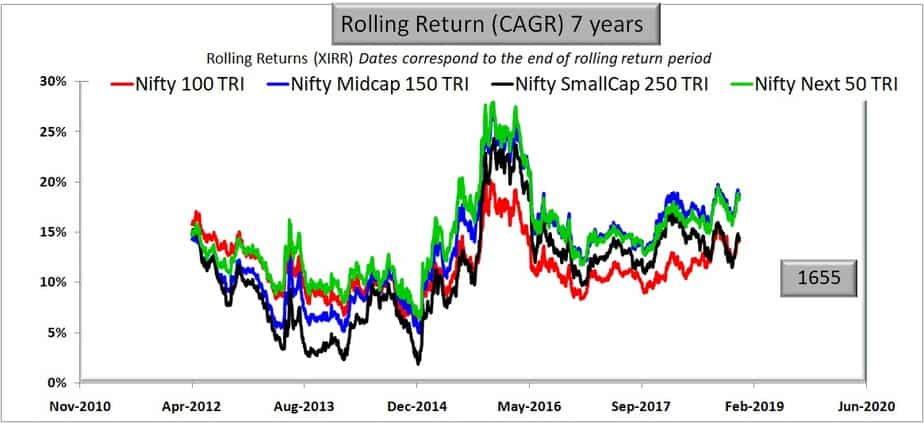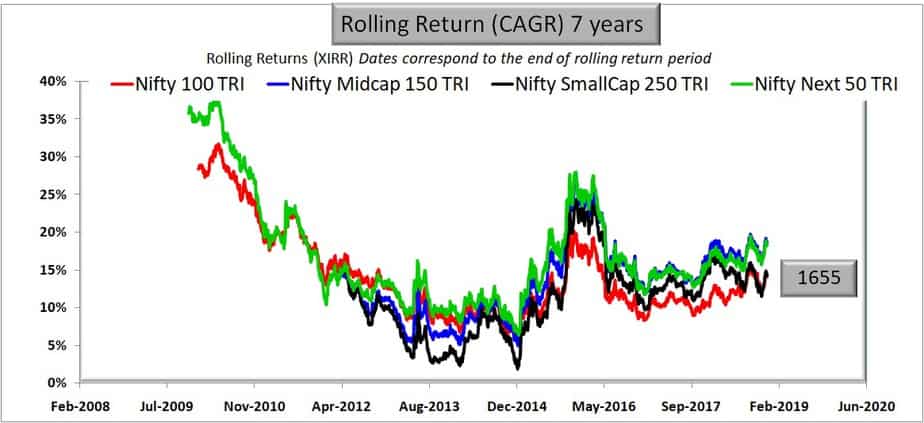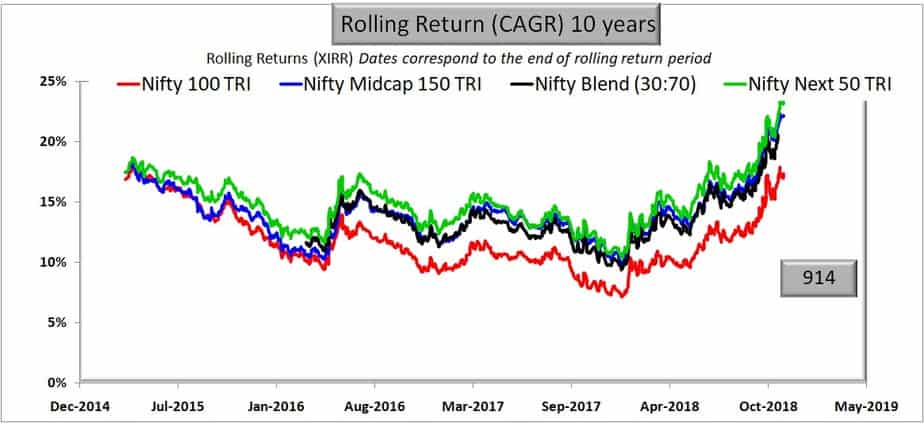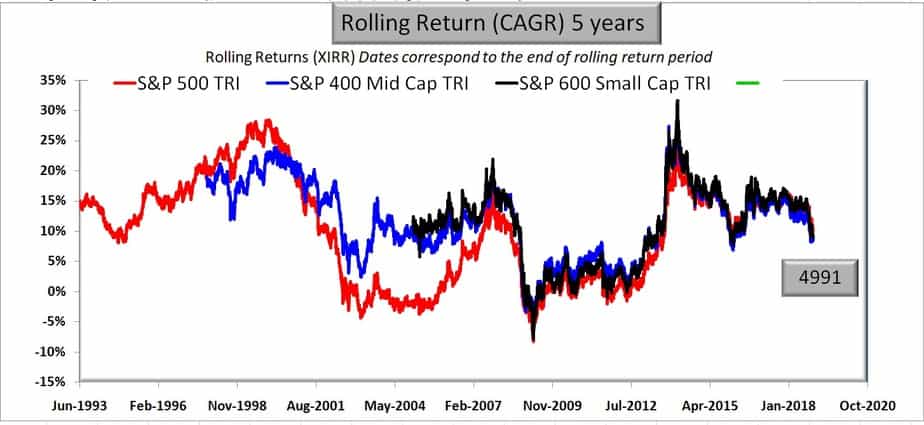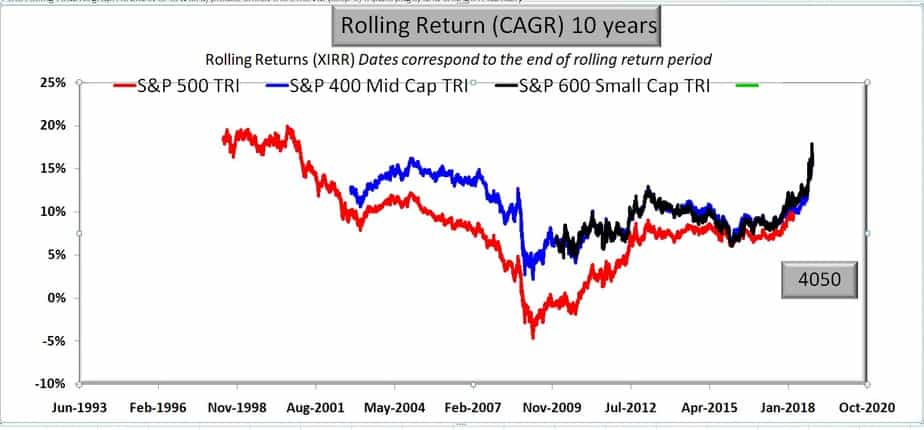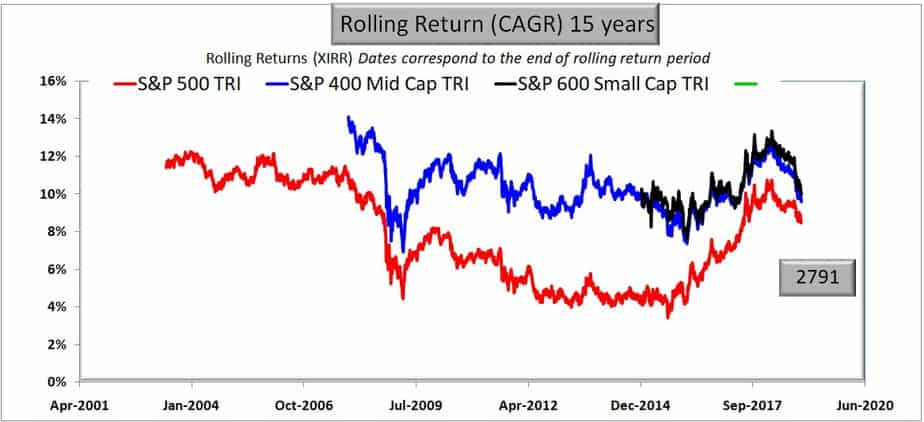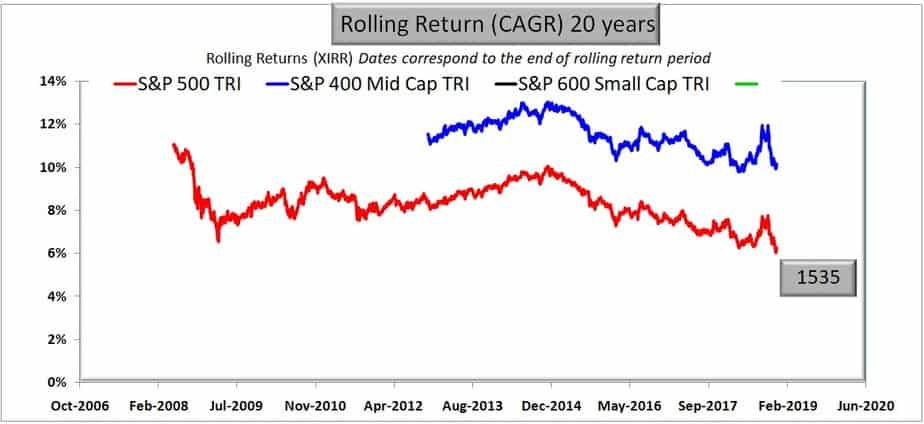Last Updated on December 29, 2021 at 12:01 pm
Many young mutual fund investors assume that their portfolios should have more of mid cap and small cap stocks or mutual funds because these will outperform large caps over the long run. As usual, such assumptions are based on “intuition” without rigorous data support. In this post, let us compare large cap, mid cap and small cap indices to find out what kind of mix is suitable for a long term investor.
Before we begin, there are several factors and limitations to be understood. To compare large cap funds with mid cap funds and small cap funds, we can only choose benchmark indices are not the actual active funds themselves. This is because if we want the best funds in each category, the analysis will suffer from survival bias. If we choose for the worst funds in each category, the study will suffer from confirmation bias! If we select all funds in each group, then we would end up with sampling issues and time issues as there are only a handful of 20Y+ large cap funds and few reasonably old mid cap funds and only young small cap funds.
This makes comparison quite tricky. So the only meaningful way is to choose benchmark indices that best represent each category. First, let us discuss results for Indian indices and then find out the situation in the USA. I am thankful to a friend who prefers anonymity for providing me with the US mid cap and small cap index data for this analysis.
Join 32,000+ readers and get free money management solutions delivered to your inbox! Subscribe to get posts via email! (Link takes you to our email sign-up form)
🔥Want to create a complete financial plan? Learn goal-based investing? Exclusive access to our DIY tools? Increase your income with your skills? Use this link to enjoy massive discounts on our robo-advisory tool & courses! 🔥
The following flowchart tells you how the NSE indices are classified. For more details, you can watch my talk on index investing: Can we get higher returns with lower risk?
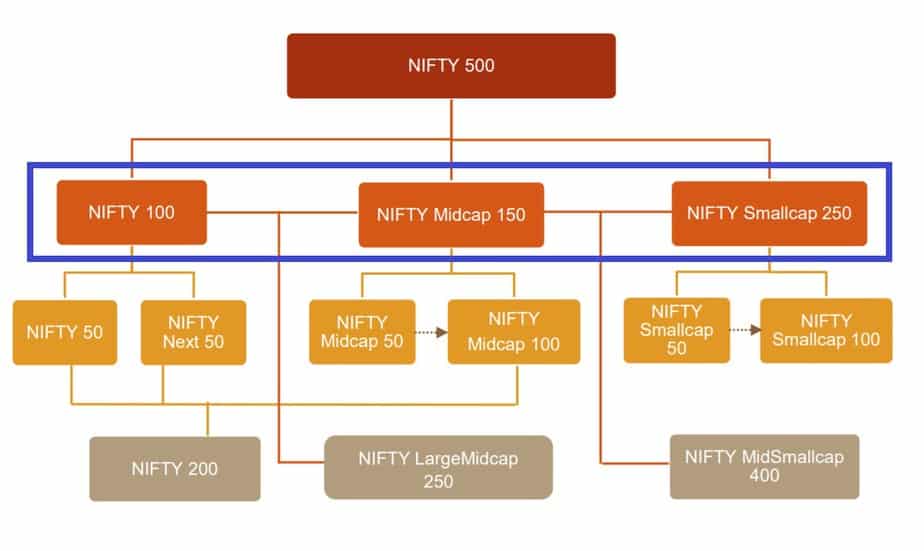 For this study, we shall use Nifty 100 for large cap, Nifty Midcap 150 for mid cap and the Nifty Small cap 250 for small cap stocks. They represent the top 100, middle 150 and bottom 250 shares of the Nifty 500. We will now look at the rolling returns of these indices for different durations.
For this study, we shall use Nifty 100 for large cap, Nifty Midcap 150 for mid cap and the Nifty Small cap 250 for small cap stocks. They represent the top 100, middle 150 and bottom 250 shares of the Nifty 500. We will now look at the rolling returns of these indices for different durations.
What is a rolling return?
To understand what a rolling return is, why it is essential for investors, please check this out.
Large Cap vs Mid Cap vs Small Cap: 5 years (Indian markets)
So let us start with five years. Please recognise we do not have enough “long term” data, so we will work with what we have.
I have added the Nifty Next 50 (the bottom 50 of Nifty 100) also for comparison as Nifty Next 50 is a benchmark Index that no active mutual fund would touch! This is not a large cap index as I have warned earlier and is as risky and as rewarding as a mid cap index. Please take some time to observe each graph.
Over five years, there is not much to differentiate among the market cap categories. This is an extended graph:
Over five years it is not possible to expect one market cap to beat another. It is merely potluck and sequence of returns.
Seven years
Did you notice how Nifty Next 50 (NN50) has a prominent (if not dominant) position? Small cap fans should understand that “long term” is not seven years!! The following is an extended chart.
Notice that even over 7y, NN50 returns can be comparable to N100 returns. N100 will have a return a tad higher than the Nifty 50 (due to market cap based weighting).
Ten years
Now, keep an eye on the number you see in the grey box: 914. These are the number of data points. Our indices are so young that even for ten year periods, there only so few points. If we increase the duration from 10 to 15, the number will dramatically drop. Lower the amount of data points, the less confident we can be about any conclusion drawn. Never forget this!
It is amusing to see the NN50 beat the Nifty Midcap 150. Look how disappointing the small cap index performance is. It is reasonable to assume that over 10Y and above, mid caps will outperform the large caps.
However, the NN50 (currently classified a large cap by SEBI and others) is also a mid cap (classification should be regarding risk, see above warning post). The NN50 is a better quality midcap index IMO than the Midcap 150.
Why have the small caps failed? When we assume small cap portfolio will beat a large cap portfolio, we also believe that many of the small cap stocks will become multi-baggers and go on to become a mid cap first and then a lareg cap. This is not the case. Not enough of them make the transition.
On the other hand, mid caps have done better. The mid cap companies have crossed the small cap barrier. So one can expect more mid caps to become large caps than small caps. Of course, this is a pretty crude explanation but should suffice for a start.
By the same token NN50 stocks have overcome two barriers and have just one step away from becoming large caps. Since there are only 50 of them in the index, the selection is also tighter.
The above graph is the reason why I believe index investors do not need a separate actively managed midcap or small cap fund in their portfolio. A portfolio of 50% Nifty 50 and 50% Nifty Next 50, which I call the NIfty blend, is all that is necessary. See: Can I start Index investing with 50% Nifty 50 and 50% Nifty Next 50? And also What is the best way to invest in Nifty Next 50 Index?
Fifteen years
This is what I mean by lack of enough data. Go to 15Y, and there are no midcap and small cap data points. 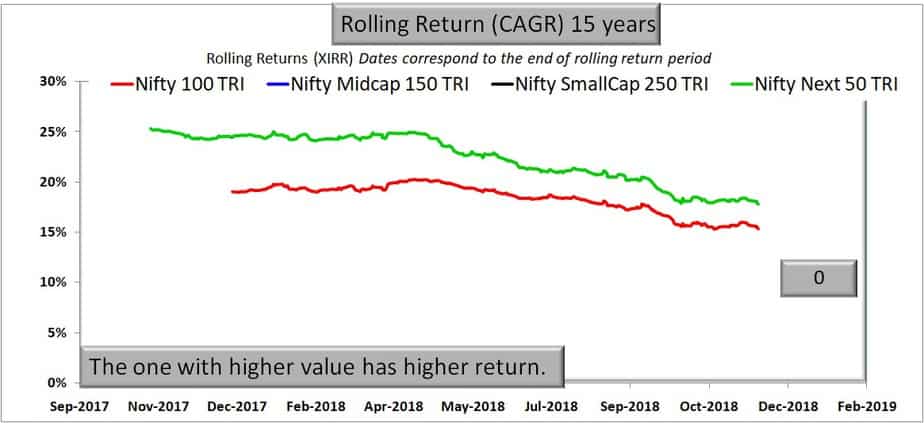
The NN50 has comfortably outperformed the N100 but notice that the margin of outperformance has been coming down. They don’t say past performance is not an indicator of future returns for nothing!
What about Nifty 100 Equal Weight?
This index consists of 100 stocks from N100 with equal weight. Two index funds from Principal and Sundaram are available as options for investors. Those who do want to choose such low AUM index funds can work instead with the NIfty Blend: two index funds: 50% of Nifty 50 and 50% Nifty Next 50. We will call this Nifty Blend (50:50)
That is pretty decent I would say. This is a good option for those who do not want the high volatility of Nifty Next 50.
What about Nifty Blend (50:50): 50% N50 + 50% NN50?
As mentioned earlier, the 50:50 blend is pretty much a proxy for N100 Equal Weight.
What about Nifty Blend (40:60): 40% N50 + 60% NN50?
What about Nifty Blend (30:70): 30% N50 + 70% NN50?
You can, adjust the blend as per your risk appetite (which will be known only when you suffer a big loss).
Large Cap vs Mid Cap vs Small Cap: 5 years (US markets)
The US market is a lot wider and deeper. The S&P 500 is a large cap index. Also, there is an S&P 400 Mid cap and S&P 600 small cap indices The mid cap and small cap indices are relatively recent in comparison.
Over five years, there is not much to say among the categories.
S&P 500 vs S&P 400 Midcap vs S&P 600 Smallcap (10 years)
Notice that there 4000 data points here compared to only 900 data points for Indian Indices. What we fail to understand is, “lack of enough data points” is a perfectly logical and technical conclusion. We must get rid of our compulsion to conclude something from everything that we see.
The mid cap index has done better here, but the small cap index fails to impress. Why would anyone take on more risk than mid caps only to get the same return?
S&P 500 vs S&P 400 Midcap vs S&P 600 Smallcap (15 years)
Again, pretty much the same conclusion as above for ten years. It makes sense to have more midcap for a genuinely long term portfolio but no small caps.
20 years
The mid cap outperformance is much cleaner here. The small cap TRI data is not available that far back (on a daily basis) and hence was not used.
Video version
Conclusions
So what can we learn from Large Cap vs Mid Cap vs Small Cap study of Indian and US markets? First, let us consider the failure of broad market small cap indices. It is quite likely that this is because few small caps go on to become multi-baggers as explained above. What smallcap gain during a bull run, they lose during a sideways movement or crash and this averages out to a poor performance. With midcaps, the stocks have probably lived through a difficult phase, and at least some of them have a chance of becoming large caps.
One can argue that actively managed Indian mid and small caps can do better. Sadly that is not the case: Why we badly need a Midcap & Smallcap Index Fund: Performance Comparison with Nifty Midcap 100 & Nifty Next 50.
In fact, after this post, I am no longer interested in a mid cap and small cap index. I think based on the present data (limited as it may be), as
Nifty Next 50 is an excellent midcap index fund.
I have no problems with having a good enough exposure to mid-caps in a long term portfolio, but my argument is, why not get that from Nifty Next 50 itself? This way, you can have only index funds in your portfolio. Either Nifty 50 + Nifty Next 50 or Sensex + Nifty Next 50. Of course, you can have 60% of NN50 if you prefer to take on more volatility.
I am trying to get into the habit of posting short videos every day and yesterday I discussed why Sensex and Nifty indices are pretty much the same.
My index investing posts seems to have contributed to a fear of missing out in the minds of active investors. Good! In the next post, we will discuss how o choose active funds in this age of indexing. For young investors and fans of passive investing, the message is clear: you only need two kinds of funds: a large cap fund for stability and a high-quality mid cap fund (like the NN50) for performance. You do not need small caps or micro caps or any other actively managed diversified equity funds.
Update: Should I now shift active mutual funds to index funds? A step by step guide

Use our Robo-advisory Tool to create a complete financial plan! ⇐More than 3,000 investors and advisors use this! Use the discount code: robo25 for a 20% discount. Plan your retirement (early, normal, before, and after), as well as non-recurring financial goals (such as child education) and recurring financial goals (like holidays and appliance purchases). The tool would help anyone aged 18 to 80 plan for their retirement, as well as six other non-recurring financial goals and four recurring financial goals, with a detailed cash flow summary.
🔥You can also avail massive discounts on our courses and the freefincal investor circle! 🔥& join our community of 8000+ users!
Track your mutual funds and stock investments with this Google Sheet!
We also publish monthly equity mutual funds, debt and hybrid mutual funds, index funds, and ETF screeners, as well as momentum and low-volatility stock screeners.
You can follow our articles on Google News

We have over 1,000 videos on YouTube!

Join our WhatsApp Channel



- Do you have a comment about the above article? Reach out to us on Twitter: @freefincal or @pattufreefincal
- Have a question? Subscribe to our newsletter using the form below.
- Hit 'reply' to any email from us! We do not offer personalised investment advice. We can write a detailed article without mentioning your name if you have a generic question.
Join 32,000+ readers and get free money management solutions delivered to your inbox! Subscribe to get posts via email! (Link takes you to our email sign-up form)
About The Author
 Dr M. Pattabiraman (PhD) is the founder, managing editor and primary author of freefincal. He is an associate professor at the Indian Institute of Technology, Madras. He has over 13 years of experience publishing news analysis, research and financial product development. Connect with him via Twitter(X), LinkedIn, or YouTube. Pattabiraman has co-authored three print books: (1) You can be rich too with goal-based investing (CNBC TV18) for DIY investors. (2) Gamechanger for young earners. (3) Chinchu Gets a Superpower! for kids. He has also written seven other free e-books on various money management topics. He is a patron and co-founder of “Fee-only India,” an organisation promoting unbiased, commission-free, AUM-independent investment advice.
Dr M. Pattabiraman (PhD) is the founder, managing editor and primary author of freefincal. He is an associate professor at the Indian Institute of Technology, Madras. He has over 13 years of experience publishing news analysis, research and financial product development. Connect with him via Twitter(X), LinkedIn, or YouTube. Pattabiraman has co-authored three print books: (1) You can be rich too with goal-based investing (CNBC TV18) for DIY investors. (2) Gamechanger for young earners. (3) Chinchu Gets a Superpower! for kids. He has also written seven other free e-books on various money management topics. He is a patron and co-founder of “Fee-only India,” an organisation promoting unbiased, commission-free, AUM-independent investment advice.Our flagship course! Learn to manage your portfolio like a pro to achieve your goals regardless of market conditions! ⇐ More than 3,500 investors and advisors are part of our exclusive community! Get clarity on how to plan for your goals and achieve the necessary corpus no matter the market condition!! Watch the first lecture for free! One-time payment! No recurring fees! Life-long access to videos! Reduce fear, uncertainty and doubt while investing! Learn how to plan for your goals before and after retirement with confidence.
Increase your income by getting people to pay for your skills! ⇐ More than 800 salaried employees, entrepreneurs and financial advisors are part of our exclusive community! Learn how to get people to pay for your skills! Whether you are a professional or small business owner seeking more clients through online visibility, or a salaried individual looking for a side income or passive income, we will show you how to achieve this by showcasing your skills and building a community that trusts and pays you. (watch 1st lecture for free). One-time payment! No recurring fees! Life-long access to videos!
Our book for kids: “Chinchu Gets a Superpower!” is now available!


Must-read book even for adults! This is something that every parent should teach their kids right from their young age. The importance of money management and decision making based on their wants and needs. Very nicely written in simple terms. - Arun.Buy the book: Chinchu gets a superpower for your child!
How to profit from content writing: Our new ebook is for those interested in getting a side income via content writing. It is available at a 50% discount for Rs. 500 only!
Do you want to check if the market is overvalued or undervalued? Use our market valuation tool (it will work with any index!), or get the Tactical Buy/Sell timing tool!
We publish monthly mutual fund screeners and momentum, low-volatility stock screeners.
About freefincal & its content policy. Freefincal is a News Media organisation dedicated to providing original analysis, reports, reviews and insights on mutual funds, stocks, investing, retirement and personal finance developments. We do so without conflict of interest and bias. Follow us on Google News. Freefincal serves more than three million readers a year (5 million page views) with articles based only on factual information and detailed analysis by its authors. All statements made will be verified with credible and knowledgeable sources before publication. Freefincal does not publish paid articles, promotions, PR, satire or opinions without data. All opinions will be inferences backed by verifiable, reproducible evidence/data. Contact Information: To get in touch, please use our contact form. (Sponsored posts or paid collaborations will not be entertained.)
Connect with us on social media
- Twitter @freefincal
- Subscribe to our YouTube Videos
- Posts feed via Feedburner.
Our publications
You Can Be Rich Too with Goal-Based Investing
 Published by CNBC TV18, this book is designed to help you ask the right questions and find the correct answers. Additionally, it comes with nine online calculators, allowing you to create custom solutions tailored to your lifestyle. Get it now.
Published by CNBC TV18, this book is designed to help you ask the right questions and find the correct answers. Additionally, it comes with nine online calculators, allowing you to create custom solutions tailored to your lifestyle. Get it now.Gamechanger: Forget Startups, Join Corporate & Still Live the Rich Life You Want
 This book is designed for young earners to get their basics right from the start! It will also help you travel to exotic places at a low cost! Get it or gift it to a young earner.
This book is designed for young earners to get their basics right from the start! It will also help you travel to exotic places at a low cost! Get it or gift it to a young earner.Your Ultimate Guide to Travel
 This is an in-depth exploration of vacation planning, including finding affordable flights, budget accommodations, and practical travel tips. It also examines the benefits of travelling slowly, both financially and psychologically, with links to relevant web pages and guidance at every step. Get the PDF for Rs 300 (instant download)
This is an in-depth exploration of vacation planning, including finding affordable flights, budget accommodations, and practical travel tips. It also examines the benefits of travelling slowly, both financially and psychologically, with links to relevant web pages and guidance at every step. Get the PDF for Rs 300 (instant download)
